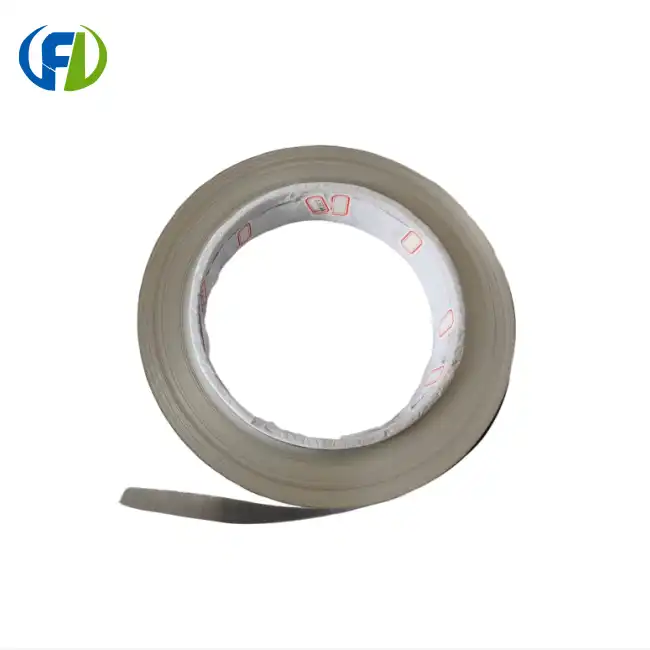ASTM B551 Key Requirements
ASTM B551 is the primary standard governing the specifications for zirconium and zirconium alloy strip, sheet, and plate. This comprehensive standard outlines several key requirements that manufacturers must meet to ensure their zirconium foil complies with industry expectations:
Chemical Composition
One of the most critical aspects of ASTM B551 is the specification of chemical composition. The standard delineates the permissible ranges for various elements within zirconium alloys, including:
- Zirconium content (typically 99.2% minimum for grade 702)
- Hafnium content (usually less than 4.5%)
- Iron and chromium levels
- Oxygen and nitrogen limits
These compositional requirements ensure that the zirconium foil possesses the desired properties for its intended applications, such as corrosion resistance and mechanical strength.
Mechanical Properties
ASTM B551 also sets forth the mechanical property requirements for zirconium foil, including:
- Tensile strength
- Yield strength
- Elongation
- Hardness
These properties are crucial for determining the foil's performance under various stress conditions and its suitability for specific applications.
Dimensional Tolerances
Precise dimensional control is essential for many applications of zirconium foil. ASTM B551 specifies tolerances for:
- Thickness
- Width
- Length
- Flatness
These tolerances ensure that the foil meets the exacting requirements of industries such as electronics, where precision is paramount.
Trace Element Limits in Commercial Grades
The control of trace elements in zirconium foil is crucial for maintaining its performance characteristics and ensuring its suitability for various applications. ASTM B551 provides detailed specifications for trace element limits in commercial grades of zirconium foil:
Impurity Control
Trace elements, even in small quantities, can significantly impact the properties of zirconium foil. ASTM B551 sets strict limits on impurities such as:
- Carbon
- Hydrogen
- Nitrogen
- Oxygen
These elements can affect the foil's corrosion resistance, mechanical properties, and performance in high-temperature environments.
Grade-Specific Limits
Different grades of zirconium foil have varying trace element limits to suit specific applications:
- Grade R60702 (commonly known as Grade 702) has lower oxygen and nitrogen limits, making it suitable for applications requiring high ductility.
- Grade R60705 (Grade 705) allows for slightly higher iron and chromium content, enhancing its strength and corrosion resistance in certain environments.
Understanding these grade-specific limits is essential for selecting the appropriate zirconium foil for a given application.
Testing and Verification
ASTM B551 mandates rigorous testing procedures to verify compliance with trace element limits:
- Spectrographic analysis
- Inert gas fusion techniques
- Vacuum hot extraction methods
These testing methodologies ensure that the zirconium foil meets the stringent purity requirements set forth by the standard.
Certification Documentation Requirements
Proper documentation and certification are crucial aspects of compliance with ASTM B551 for zirconium foil manufacturers. The standard outlines specific requirements for certification documentation to ensure traceability and quality assurance:
Test Reports
ASTM B551 requires comprehensive test reports that include:
- Chemical composition analysis results
- Mechanical property test data
- Dimensional measurements
- Heat treatment records (if applicable)
These reports provide a detailed record of the foil's properties and manufacturing process, ensuring compliance with the standard's specifications.
Material Traceability
Certification documentation must include information that allows for material traceability, such as:
- Lot numbers
- Melt numbers
- Manufacturing date
- Production facility information
This traceability is essential for quality control and potential issue resolution in the future.
Certification Statements
ASTM B551 requires specific certification statements to be included in the documentation, affirming that:
- The material meets all requirements of the standard
- Testing was performed in accordance with specified methods
- The information in the certification is accurate and complete
These statements provide assurance to customers that the zirconium foil complies with all relevant specifications and quality standards.
Additional Documentation
Depending on the specific application or customer requirements, additional documentation may be necessary, such as:
- Surface finish reports
- Special testing results
- Packaging and handling certifications
These supplementary documents ensure that the zirconium foil meets any additional criteria beyond the basic ASTM B551 requirements.
In conclusion, understanding and adhering to ASTM standards for zirconium foil grades is essential for ensuring the quality, reliability, and performance of this versatile material. From chemical composition and mechanical properties to trace element control and certification documentation, these standards provide a comprehensive framework for the production and use of zirconium foil across various industries.
If you're looking for high-quality zirconium foil that meets or exceeds ASTM standards, look no further than Baoji Freelong New Material Technology Development Co., Ltd. Located in Baoji City, China's Titanium Valley, we specialize in the production and export of zirconium, titanium, nickel, niobium, tantalum, and other metal materials and alloys. Our commitment to quality and service has earned us the trust of clients and partners worldwide, including those in Australia, Korea, Germany, the US, UK, Malaysia, AZ, Middle East, and Taiwan. We pride ourselves on meeting and often surpassing our customers' quality expectations. For more information or to discuss your zirconium foil needs, please don't hesitate to contact us at jenny@bjfreelong.com. Let us help you find the perfect zirconium foil solution for your application!
References
1. ASTM International. (2021). ASTM B551/B551M-21 Standard Specification for Zirconium and Zirconium Alloy Strip, Sheet, and Plate. West Conshohocken, PA: ASTM International.
2. Schemel, J. H. (2017). ASTM Manual on Zirconium and Hafnium. West Conshohocken, PA: ASTM International.
3. Lustman, B., & Kerze, F. (2018). The Metallurgy of Zirconium. New York: McGraw-Hill.
4. Boyko, E. R. (2019). Corrosion of Zirconium and Its Alloys. In Uhlig's Corrosion Handbook (3rd ed.). Hoboken, NJ: John Wiley & Sons.
5. Adamson, R., & Cox, B. (2020). Microstructure and Properties of Zirconium Alloys in Nuclear Applications. Journal of Nuclear Materials, 485, 15-45.
6. Krishnan, R., & Asundi, M. K. (2021). Zirconium Alloys in Nuclear Technology. In Proceedings of the Symposium on Zirconium in the Nuclear Industry. Philadelphia, PA: ASTM International.


_1745457541912.webp)
_1745383111576.webp)
_1744600755689.webp)
_1745305883534.webp)